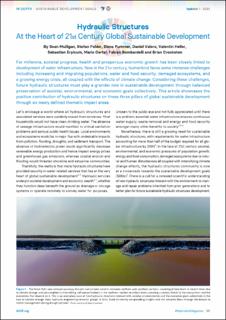Hydraulic Structures- At the Heart of 21st Century Global Sustainable Development
| dc.contributor.author | Mulligan, Sean | |
| dc.contributor.author | Felder, Stefan | |
| dc.contributor.author | Pummer, Elena Marianne | |
| dc.contributor.author | Valero, Daniel | |
| dc.contributor.author | Heller, Valentin | |
| dc.contributor.author | Erpicum, Sebastien | |
| dc.contributor.author | Oertel, Mario | |
| dc.contributor.author | Bombardelli, Fabian | |
| dc.contributor.author | Crookston, Brian | |
| dc.date.accessioned | 2023-03-21T08:14:53Z | |
| dc.date.available | 2023-03-21T08:14:53Z | |
| dc.date.created | 2023-03-20T18:07:49Z | |
| dc.date.issued | 2023 | |
| dc.identifier.issn | 1388-3445 | |
| dc.identifier.uri | https://hdl.handle.net/11250/3059423 | |
| dc.description.abstract | For millennia, societal progress, health and prosperous economic growth has been closely linked to development of water infrastructure. Now in the 21st century, humankind faces some immense challenges including increasing and migrating populations, water and food security, damaged ecosystems, and a growing energy crisis, all coupled with the effects of climate change. Considering these challenges, future hydraulic structures must play a grander role in sustainable development through balanced preservation of societal, environmental, and economic goals collectively. This article showcases the positive contribution of hydraulic structures on these three pillars of global sustainable development through six newly defined thematic impact areas. | en_US |
| dc.language.iso | eng | en_US |
| dc.publisher | IAHR | en_US |
| dc.title | Hydraulic Structures- At the Heart of 21st Century Global Sustainable Development | en_US |
| dc.title.alternative | Hydraulic Structures- At the Heart of 21st Century Global Sustainable Development | en_US |
| dc.type | Journal article | en_US |
| dc.description.version | publishedVersion | en_US |
| dc.source.volume | 1 | en_US |
| dc.source.journal | HydroLink | en_US |
| dc.identifier.cristin | 2135500 | |
| cristin.ispublished | true | |
| cristin.fulltext | original |
